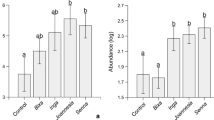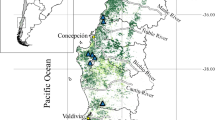Abstract
Tsuga canadensis is often considered a foundation species because of its influence on the biological and ecological processes of upland forest systems. With hemlock woolly adelgid (Adelges tsugae; HWA)-induced mortality of T. canadensis in southern Appalachian upland forests, there is a crucial need to understand the regeneration dynamics of this tree species. This research was conducted within mature T. canadensis forests of Great Smoky Mountains National Park (GSMNP) prior to widespread HWA infestation. Tsuga canadensis regeneration abundance is lower than has been reported in more northern locales, but varies widely among sites in the southern Appalachian Mountains. Ordination results suggest landscape-scale patterns of regeneration abundance that are influenced by gradients in understory Rhododendron maximum cover, soil sand and nutrient content. Regression models reinforce the observed gradients in regeneration abundance. Sites with abundant T. canadensis regeneration have less R. maximum cover, soil sand and litter depth, but more soil nutrient availability. Tsuga canadensis seedlings and saplings tend to be spatially aggregated at the 14 × 21 m plot scale. Sites with spatially aggregated seedlings and saplings have greater canopy openness and more species with gap affinity. This research elucidates associations between successful T. canadensis regeneration and site factors such as soil nutrient availability and canopy dynamics. More forest surveys are required to understand the conditions necessary for successful T. canadensis regeneration. Land managers involved in forest restoration efforts may have to utilize appropriate silvicultural techniques conjoined with R. maximum removal operations to regenerate T. canadensis in southern Appalachian upland forests.


Similar content being viewed by others
References
Allen AW, Jordan PA, Terrell JW (1987) Habitat suitability index models: Moose, Lake Superior region. USDI Fish and Wildlife Service Biological Report 82
Anderson RC, Loucks OL (1979) Whitetail deer (Odocoileus virginianus) influence on structure and composition of T. canadensis forests. J Appl Ecol 16:855–861
Barnes BV (1991) Deciduous forests of North America. In: Rhorig E, Ulrich B (eds) Temperate deciduous forests. Elsevier, Amsterdam, pp 219–344
Beers TW, Dress PE, Wensel LC (1966) Aspect transformation in site productivity. Res J Forest 64:691–692
Catovsky S, Bazzaz FA (2000) The role of resource interactions and seedling regeneration in maintaining a positive feedback in hemlock stands. J Ecol 88:100–112
Catovsky S, Bazzaz FA (2002) Feedbacks between canopy composition and seedling regeneration in mixed conifer broad-leaved forests. Oikos 98:403–420
Coffman MS (1978) Eastern hemlock germination influenced by light, germination media, and moisture content. Mich Bot 17:99–103
Cook ER, Cole J (1991) On predicting the response of forests in eastern North America to future climatic change. Clim Change 19:271–282
Dobbs MM, Parker AJ (2004) Evergreen understory dynamics in Coweeta forest, North Carolina. Phys Geogr 25:481–498
Foth HD (1990) Fundamentals of soil science. Wiley, New York
Frelich LE (2002) Forest dynamics and disturbance regimes. Cambridge University Press, Cambridge
Frelich LE, Lorimer CG (1991) Natural disturbance regimes in hemlock-hardwood forests of the upper Great Lakes region. Ecol Monogr 61:145–164
Frelich LE, Calcote RR, Davis MD, Pastor J (1993) Patch formation and maintenance in an old-growth hemlock-hardwood forest. Ecology 74:513–527
Godman RM, Lancaster K (1990) Tsuga canadensis (L.) Carr. eastern hemlock. In: Burns RM, Honkala BH (eds) Silvics of North America I. Conifers. USDA Forest Service Agricultural Handbook 654
Haney JC (1997) Spatial incidence of Barred Owl (Strix varia) reproduction in old-growth forest of the Appalachian Plateau. J Raptor Res 31:241–252
Harper JL (1977) Population biology of plants. Academic Press, London
Hart JL (2008) Eastern hemlock decline and persistence of disjunct populations near its southern boundary. J Ala Acad Sci 79:174–180
Hart JL, van de Gevel SL, Sakulich J, Grissino-Mayer HD (2010) Influence of climate and disturbance on the growth of Tsuga canadensis at its southern limit in eastern North America. Trees 24:621–633
Hedman CW, Van Lear DH (1995) Vegetative structure and composition of southern Appalachian riparian forests. Bull Torrey Bot Club 122:134–144
Hill MO, Gauch HG (1980) Detrended correspondence analysis: an improved ordination technique. Vegetation 42:58–74
Hooper RG (1978) Cove forests: bird communities and management options. In: DeGraaf RM (ed) Proceedings of the workshop on management of southern forests for Nongame Birds. USDA Forest Service Technical Report SE-14
Houk R (1993) Great Smoky Mountains. Houghton Mifflin Company, New York
Johnson KD (2010) Personal communication regarding eastern hemlock and hemlock woolly adelgid in Great Smoky Mountains National Park
Johnson KD, Taylor G, Remaley T (2005) Managing hemlock woolly adelgid and balsam woolly adelgid at Great Smoky Mountains National Park. In: Onken B and Reardon R (eds) Proceedings of the third symposium on hemlock woolly adelgid in the eastern United States. USDA Forest Service FHTET-2005-01
Kemp S (1998) Trees of the smokies. Great Smoky Mountains Natural History Association, Gatlinburg
Kincaid JA (2007) Compositional and environmental characteristics of Tsuga canadensis (L.) Carr. forests in the southern Appalachian Mountains, USA. J Torrey Bot Soc 134:479–488
Kincaid JA, Parker AJ (2008) Structural characteristics and canopy dynamics of Tsuga canadensis in forests of the southern Appalachian Mountains, USA. Plant Ecol 199:265–280
Krebs CJ (1999) Ecological methodology. Addison-Wesley Educational Publishers Inc, New York
Little EL (1998) National Audubon Society field guide to North American tress: eastern region. Alfred A. Knopf, Inc, New York
Long ZT, Carson WP, Peterson CJ (1998) Can disturbance create refugia from herbivores: an example with hemlock regeneration and treefall mounds. J Torrey Bot Soc 125:165–168
McClure MS (1991) Density-dependent feedback and population cycles in Adelges tsugae (Homoptera: Adelgidae) on T. canadensis. Environ Entomol 20:258–264
McCune B, Mefford MJ (1999) PC-ORD. Multivariate analysis of ecological data, Version 4. MjM Software Design, Gleneden Beach
Mitchell JM (1999) Habitat relationships of five northern bird species breeding in hemlock ravines in Ohio, USA. Nat Area J 19:3–11
Mladenoff DJ (1987) Dynamics of nitrogen mineralization and nitrification in hemlock and hardwood treefall gaps. Ecology 68:1171–1180
Mladenoff DJ, Stearns F (1993) Eastern hemlock regeneration and deer browsing in the Great Lakes region: a re-examination and model simulation. Conserv Biol 7:889–900
Monk CD, McGinty DT, Day FP (1985) The ecological importance of Kalmia latifolia and Rhododendron maximum in the deciduous forests of the southern Appalachians. Bull Torrey Bot Club 112:187–193
Myers JH (1978) Selecting a measure of dispersion. Environ Entomol 7:619–621
Nelson CR (1997) Hemlock regeneration in the Nicolet National Forest, Wisconsin. Master’s Thesis, University of Wisconsin-Madison
Nilsen ET, Clinton BD, Lei TT, Miller OK, Semones SW, Walker JF (2001) Does Rhododendron maximum L. (Ericaceae) reduce the availability of resources above and belowground for canopy tree seedlings? Am Midl Nat 145:325–343
Olson JS, Stearns FW, Nienstaedt H (1959) Eastern hemlock seeds and seedlings: response to photoperiod and temperature. Connecticut Agricultural Experiment Station Bulletin No 620
Orwig DA, Foster DR (1998) Forest response to the introduced hemlock woolly adelgid in southern New England. J Torrey Bot Soc 125:60–73
Orwig DA, Foster DR, Mausel DL (2002) Landscape patterns of hemlock decline in New England due to the introduced hemlock woolly adelgid. J Biogeogr 29:1475–1487
Owen OS, Chiras DD (1995) Natural resource conservation: management for a sustainable future. Prentice Hall, New Jersey
Parker AJ (1982) The topographic relative moisture index: an approach to soil-moisture assessment in mountain terrain. Phys Geogr 3:160–169
Parker AJ (1993) Structural variation and dynamics of lodgepole pine forests in Lassen Volcanic National Park, California. Ann Assoc Am Geogr 83:613–629
Parshall T (1995) Canopy mortality and stand-scale change in a northern hemlock-hardwood forest. Can J Forest Res 25:1466–1478
Phillips D, Murdy W (1985) Effects of rhododendron on regeneration of southern Appalachian hardwoods. For Sci 31:226–233
Rankin WT, Tramer EJ (2002) The gap dynamics of canopy trees of a Tsuga canadensis forest community. Northeast Nat 9:391–406
Rivers CT, Van Lear DH, Clinton BD, Waldrop TA (2000) Community composition in canopy gaps as influenced by presence or absence of Rhododendron maximum. In: Haywood JD (ed) Proceedings of the tenth biennial southern silvicultural research conference. USDA Forest Service General Technical Report SRS-30
Rogers RS (1978) Forests dominated by hemlock (Tsuga canadensis): distribution as related to site and postsettlement history. Can J Bot 56:843–854
Rogers LL, Wilker GA, Scott SS (1990) Managing natural populations of black bears in wilderness. In: Lime DW (ed) Managing America’s enduring wilderness resource: proceedings of the conference. Minnesota Agricultural Experiment Station
Rooney TP, Waller DM (1998) Local and regional variation in hemlock seedling establishment in forests of the upper Great Lakes region, USA. For Ecol Manag 111:211–224
Rooney TP, McCormick RJ, Solheim SL, Waller DM (2000) Regional variation in recruitment of hemlock seedlings and saplings in the upper Great Lakes, USA. Ecol Appl 10:1119–1132
Runkle JR (1982) Patterns of disturbance in some old growth mesic forests of eastern North America. Ecology 63:1533–1546
Runkle JR (1998) Changes in southern Appalachian canopy trees sampled thrice. Ecology 79:1768–1780
Runkle JR, Yetter TC (1987) Treefalls revisited: gap dynamics in the southern Appalachians. Ecology 68:417–424
R-Well (2005) Desktop Mapping System (DMS) 5.0. R-WEL, Inc, Athens
Secrest HC, MacAloney HJ, Lorenz RC (1940) Causes of decadence of hemlock at the Menominee Indian Reservation, Wisconsin. J For 39:3–12
Snyder CD, Young JA, Lemarie DP, Smith DR (2002) Influence of eastern hemlock (Tsuga canadensis) forests on aquatic invertebrate assemblages in headwater streams. Can J Fish Aquat Sci 59:262–275
StataCorp (2003) Stata Statistical Software: Release 8.0. Stata Corporation, College Station
Sullivan KA, Elison AM (2006) The seedbank of hemlock forests: implications for regeneration following hemlock decline. J Torrey Bot Soc 133:393–402
Tardiff J, Brisson J, Bergeron Y (2001) Dendroclimatic analysis of Acer saccharum, Fagus grandifolia, and Tsuga canadensis from an old-growth forest, southwestern Quebec. Can J For Res 31:1491–1501
Ter Braak CJF (1995) Ordination. In: Jongman RHG, Ter Braak CJ, Tongeren OFR (eds) Data analysis in community and landscape ecology. Cambridge University Press, Cambridge
Van Lear DH, Vandermast DB, Rivers CT, Baker TT, Hedman CW, Clinton BD, Waldrop TA (2002) American chestnut, rhododendron, and the future of Appalachian cove forests. In: Outcalt KW (ed) Proceedings of the eleventh biennial southern silvicultural research conference. USDA Forest Service General Technical Report SRS-48
Walker JF, Miller OK, Lei TT, Semones S, Nilsen ET, Clinton BD (1999) Suppression of ectomycorrhizae on canopy tree seedlings in Rhododendron maximum L. (Ericaceae) thickets in the southern Appalachian Mountains. Mycologia 9:49–56
Waller DM, Alverson WS, Solheim SL (1996) Local and regional factors influencing the regeneration of eastern hemlock. In: Mroz G, Martin J (eds) Hemlock ecology and management: proceedings of a regional conference on ecology and management of eastern hemlock. Department of Forestry, Michigan Technical University, Houghton
Webster J (2010) Personal communication regarding eastern hemlock and hemlock woolly adelgid in Great Smoky Mountains National Park
Webster CR, Lorimer CG (2002) Single-tree versus group selection in hemlock- hardwood forests: are smaller openings less productive? Can J For Res 32:591–604
Woods KD (2000a) Dynamics of late-successional hemlock-hardwood forests over three decades. Ecology 81:110–126
Woods KD (2000b) Long-term change in spatial pattern in a late-successional hemlock-hardwood forest. J Ecol 88:267–282
Young RF, Shields KS, Berlyn GP (1995) Hemlock woolly adelgid (Homoptera: Adelgidae): stylet bundle insertion and feeding sites. Ann Entomol Soc Am 88:827–835
Ziegler SS (2002) Disturbance regimes of hemlock-dominated old-growth forests in northern New York, USA. Can J For Res 32:2106–2115
Acknowledgments
This research was supported by a Carlos C. Campbell Memorial Fellowship from the Great Smoky Mountains Conservation Association. I would like to thank Mike Jenkins and Kristine Johnson for providing me with information concerning T. canadensis resources in GSMNP. I would also like to thank Thomas Jordan, Heather Phares, and Joel Sabin for their assistance with image analysis and cartographic design. For comments that improved this manuscript, I thank Albert Parker and two anonymous reviewers.
Author information
Authors and Affiliations
Corresponding author
Additional information
Communicated by S. M. Landhäusser.
Rights and permissions
About this article
Cite this article
Kincaid, J.A. Regeneration dynamics of Tsuga canadensis in the southern Appalachian Mountains, USA. Trees 26, 1045–1056 (2012). https://doi.org/10.1007/s00468-012-0681-z
Received:
Revised:
Accepted:
Published:
Issue Date:
DOI: https://doi.org/10.1007/s00468-012-0681-z




